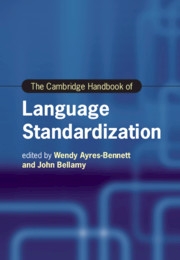Book contents
- The Cambridge Handbook of Language Standardization
- cambridge handbooks in language and linguistics
- The Cambridge Handbook of Language Standardization
- Copyright page
- Contents
- Figures
- Tables
- Contributors
- Introduction
- Part I Revisiting Models and Theories of Language Standardization
- Part II Legitimacy, Authority and the Written Form
- Part III Norms, Literacy and Education
- Part IV Beyond the National
- 19 Transnational Standards of Languages
- 20 Standardization across State Boundaries
- 21 Language Modernization in the Chinese Character Cultural Sphere
- 22 Linguistic Norms, Centre–Periphery Dynamics and the Tension between Uniformity and Diversity in Processes of Standardization
- 23 When Ethnic Boundaries and Language Boundaries Mismatch
- 24 The Standardization of a Stateless Language
- Part V Standardization in Late Modernity
- Name Index
- Subject Index
- References
19 - Transnational Standards of Languages
The Rise and Codification of National Varieties
from Part IV - Beyond the National
Published online by Cambridge University Press: 01 July 2021
- The Cambridge Handbook of Language Standardization
- cambridge handbooks in language and linguistics
- The Cambridge Handbook of Language Standardization
- Copyright page
- Contents
- Figures
- Tables
- Contributors
- Introduction
- Part I Revisiting Models and Theories of Language Standardization
- Part II Legitimacy, Authority and the Written Form
- Part III Norms, Literacy and Education
- Part IV Beyond the National
- 19 Transnational Standards of Languages
- 20 Standardization across State Boundaries
- 21 Language Modernization in the Chinese Character Cultural Sphere
- 22 Linguistic Norms, Centre–Periphery Dynamics and the Tension between Uniformity and Diversity in Processes of Standardization
- 23 When Ethnic Boundaries and Language Boundaries Mismatch
- 24 The Standardization of a Stateless Language
- Part V Standardization in Late Modernity
- Name Index
- Subject Index
- References
Summary
The rise of standard forms of language for both the English- and the Spanish-speaking worlds is a development which benefits from contrast. Both languages spread overseas, with national standards arising during the later colonial period through a process of supraregionalization by which local varieties lost strong vernacular features and came to function as non-stigmatized, publically accepted varieties. However, the details of these developments are different and the cultural attitudes to varieties spoken in the source countries in Europe vary considerably, determining the ways in which standards are viewed and used in both the Anglophone and the Hispanophone worlds.
Keywords
- Type
- Chapter
- Information
- The Cambridge Handbook of Language Standardization , pp. 519 - 545Publisher: Cambridge University PressPrint publication year: 2021



